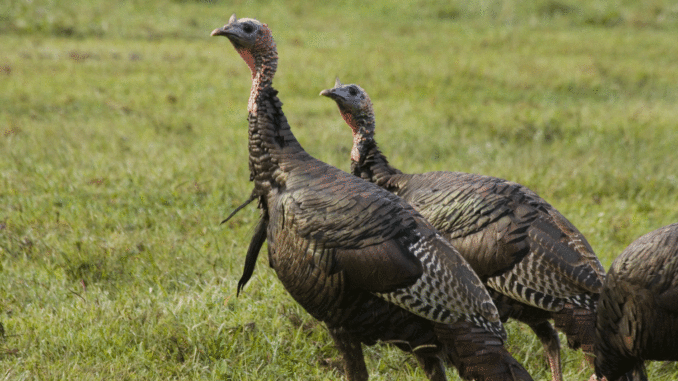
Early season Lowcountry gobblers often require special attention from hunters because they’re in the peak of breeding period.
Getting a 2-week jump-start on turkey season in South Carolina’s Lowcountry is certainly a bonus, but it does come with some issues that hunters must overcome.
Charles Ruth, the deer and turkey project supervisor for the S.C. Department of Natural Resources, said in addition to the typical wily ways of these gobblers, his data indicates that the spring mating season is already in full swing when the early season opens.
“The March 15 season opener (in the Lowcountry) is very popular with a lot of hunters,” Ruth said. “However, (from) about the middle of March though the end of the month, the turkeys are actually in the peak of their breeding season. Most hens are not sitting on nests, so they are very responsive to gobblers. Gobblers often do not gobble as much because they don’t have to, and hunters frequently encounter what they refer to as ‘henned-up’ gobblers.”
One Lowcountry hunter who consistently solves this problem and takes big gobblers is William Pegler of Moncks Corner. Peagler, 57, a a lawyer and also mayor of the town, and as any adept public official will do, he has learned to adapt. In this case, he adapts to the ever-changing habits of the Lowcountry gobblers throughout the spring season.
“I’ve been hunting turkeys for 30 years here in the Lowcountry, and being able to adapt to change is one of the real keys to success,” Peagler said. “(From) when the early season opens in mid-March until the season closes on May 1, there will constant change in the behavior of these gobblers. The key to being successful is adjusting to their changes.
“It’s tough to make a turkey do something he doesn’t want to do. The trick is to get in his way while he’s doing what the thinks he wants to do.”
Peagler hunts throughout the Lowcountry, but his home range is generally in Berkeley County, and more specifically, at Blackbrier Plantation near Cross. Peagler owns the property, which is managed primarily for quail hunting, but turkey and deer hunts are booked through Blacks Camp. Peagler said managing for quail creates ideal turkey habitat.
He said one key to success is to begin every hunt with an open mind about what the gobblers are doing and where he’ll find them. He said accepting the hunting attitude that quick and frequent movements may be necessary is crucial.
Peagler’s start-up plan will vary based on whether he’s roosted a bird the evening prior to the hunt. When possible he’ll roost a bird, but that’s not always an option.
“Roosting a bird and having a starting point is important, but I don’t believe it’s an absolute necessity,” he said. “So many different things can happen, particularly in the early portion of the season. The advantage of roosting a bird the evening before is that it does put me in the position of hearing a bird gobble early and hopefully have time to maneuver and get position on him before he even flies down.”
If he doesn’t roost a bird, Peagler will travel quickly and quietly though roosting areas and listen for gobbles.
“The quicker I can get on a bird early in the season and the closer I can get to him before he flies down, the better my odds,” he said. “Birds are breeding at this time of the season, and hen competition is a serious consideration.”
Peagler said that’s why one of his best early season tactics is to use decoys, but they’re less effective as the season wears on.
“I’ve had excellent success with decoys early in the season, especially when the birds are grouped up in a breeding situation,” he said. “If I place the decoy where it can be seen by the gobbler, it has a strong attractive power. I often use one or two hen decoys when I set up early on a roosted gobbler. Later on in the morning, if I’m hunting open areas where turkeys naturally congregate during the day, decoys are excellent. When a gobbler see’s a hen decoy, the bird will often travel a long distance to get to them, especially early in the season.
“But as the season progresses, my experience has been the effectiveness of decoys decreases,” he said. “It may be they just get decoy-wise. While I will still use them on occasion, I use them less as we get into April. For my style of hunting, after the peak of the mating season, gobblers are more responsive to calling, and there is less need for decoys.”
Robby Gregory of Moncks Corner occasionally guides at Blackbrier and has hunted all across the Lowcountry for the past 15 years — a real accomplishment since he’s only 25. He said his strategy will always reflect what that particular gobbler seems to want as the season progresses.
“My experience has been to start with the soft and subtle approach and ramp it up if necessary to more aggressive calling as needed,” Gregory said. “Many older gobblers, those long-spurred ones we all like to see, are very woods-wise, and the old saying ‘Less can be more’ in terms of talking to a turkey … is accurate. I listen to their response to my calls and do what my instincts and experience tells me is right for that particular turkey.”
Gregory is versatile with a number of different calls, and has a basic plan for their use. He will use mouth, box and slate or glass calls to strike a gobbler, and then, as the bird approaches and needs a finishing touch, he’ll typically rely on a mouth call to eliminate movement.
“I try to be proficient with a number of calls, again to be able to produce a variety of sounds, looking for the right sound for a particular gobbler,” he said. “I don’t get locked into a single type of call.”
Gregory will also use his natural voice at times, making subtle hen sounds, and he has had excellent success with this technique. He said one of his most productive natural-voice calls is the gobble, which he uses with great success, especially late in the season.
“It’s part of the ever-changing process here in our part of the state,” he said. “As hens begin to sit on the nests, competition seems to grow, and the gobble call can be highly productive the last couple of weeks of April.”
Gregory said if he doesn’t connect with a gobbler in the morning his strategy will be one of moving around, prospecting for a willing bird.
“My experience is that after the early morning hunt, gobblers are either locked in with hens or on the move, and actually, mid-morning through the rest of the day can be highly productive,” he said. “I will use what cover is available, be quiet as possible, and move though the woods listening for a gobbling bird. I will vary my locator calls, using crow calls at times as well as hen sounds from a variety of calls.
“When I get a response, I’ll usually quickly settle in to a good setup and work that bird. The success rate for mid-morning though the afternoon is quite high in terms of getting a bird within range if you can get one to gobble to a hen call. If a gobbler responds to my crow call, I’ll move into good position and setup and call from that point. His response will dictate if any further movement is needed on my part.”
Both Gregory and Peagler agree on the No. 1 Lowcountry hunting strategy, and that revolves around patience. They will both move as much as necessary to find gobblers but when they are working a bird, patience is a key.
“Sometimes you must move on a gobbler, but it will be evident by his response, or lack of, if that’s necessary,” Gregory said. “When I set up, I am quiet, still and patient. Sometimes these gobblers will gobble once, then come in silently. I give them plenty of time, and typically, my calling is soft and subtle. Calling too fast or loud can often turn these birds off.
“I’ve learned that impatience and moving too soon will frequently get you busted by a quiet longbeard. If a bird gobbles mid-day or afternoon, then gets quiet, I give the bird the benefit of doubt that he is approaching silently. It is a great tactic and actually takes good woodsmanship skills to pull off successfully.”
William Peagler used Lowcountry lawyer lingo to summarize his season-long plan of attack.
“The gobbler is the judge and jury,” he said. “You must make an excellent presentation when pleading your case and convince that gobbler you are a hen telling him the truth. Then, your closing argument is the collective array of calling, tactical moves and ability to adapt to what he and the prevailing situation requires and let him make the right decision. When he does and approaches to gun range, judgment is swift, and court is adjourned.”
DESTINATION INFORMATION
WHEN TO GO — Turkey season on private land in the 12 Lowcountry counties opens March 15, two weeks before the rest of South Carolina. Check all SCDNR rules and regulations when planning a trip. Hunting on public WIldlife Management Areas does not open until April 1.
BEST TECHNIQUES — Get out early and get a good setup on a gobbler while he’s on the roost, before he hooks up with hens, since it’s prime mating season. If that doesn’t work, continue to hunt hard, move a lot and call frequently throughout the day. Hone your calling skills so you can use a variety of calls and give Lowcountry gobblers ample time to move in quietly which they are prone to do during mid-day time periods.
HUNTING INFO/GUIDES — Need some Lowcountry plantation advertisers here…. Blackbrier Plantation, Cross, 843-753-2231, http://www.blackscamp.com/home.html. See also GUIDES & CHARTERS in Classifieds.
ACCOMMODATIONS — S.C. Association of Visitors Bureau, http://www.discoversouthcarolina.com/.
MAPS — While only private lands are open from March 15-31, Lowcountry WMAs have excellent hunting in April. Tops on the list is the Francis Marion National Forest. For detailed maps showing WMA lands in South Carolina write WMA MAPS, SCDNR, P.O. Box 167, Columbia, SC, 29202 or call 803-734-3886.

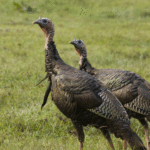
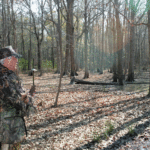
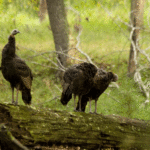
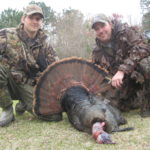




Be the first to comment